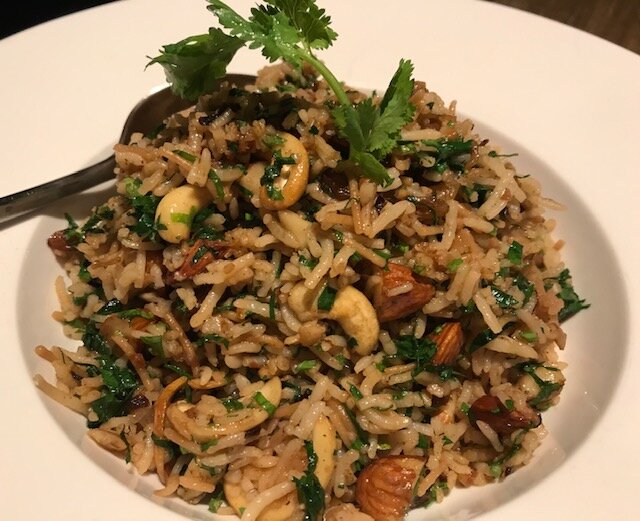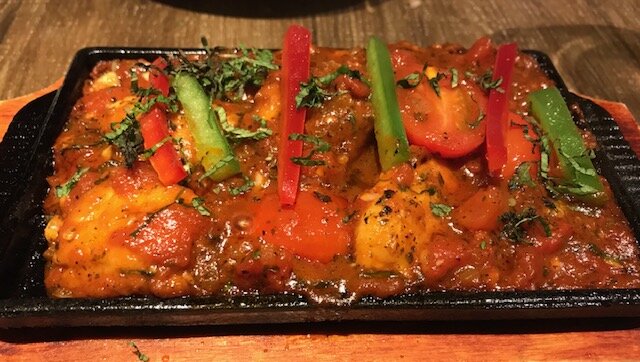Eastern Mediterranean food is citrus orchards, vineyards, stony fields, small farms, flocks and shepherds. It’s olives and lemons and dates and sesame seeds and capers and chickpeas and pomegranates and grapes and grape leaves and tomatoes so delicious you fall to your knees. It’s rustic, usually Halal, sometimes Kosher, sheepy, lamby, goaty. It’s all the denizens of the wine dark sea. As you travel westward the food gradates in style, preparation, and ingredients, markedly different by the time you reach France, Italy, Spain (though it still shares an obsession with olives and olive oil). The food of Lamees, moored in a lively section of Kowloon, is Eastern Mediterranean.
The interior is decorated with middle-eastern artifacts, hookahs, ornate coffeepots, at least one bottle containing olives, and decorative platters on the walls. It is cluttered, including a leftover Christmas decoration, a hook with many staff jackets hanging near your table, a large blender sitting out, and just general stuff. The menus -- printed on thick, glossy paper -- are scuffed, an impression that extends to the tables and entire premises. This is very date apropos for you. After all, it’s great food you’re after. You can easily feel romantic in a lost-and-found bin, but perhaps not quite so much for your wife — an evangelist for tidiness -- who color coordinates cushions in her sleep.
You start with two handsome platters, three dips each. The first has classic hummus. Though you might have preferred a little more lemon, it is delicious with a prominent taste of tahini (imported from Jordan, Chef Tarek Alali’s homeland). You and your wife enthusiastically agree that the baba ghanoush is the best you’ve ever had, containing delightful crunches of red and green bell pepper. You’ve never before had truffled hummus and now it’s in your dreams. The next platter contains red pepper dip (quite similar to muhamarra) – based on nuts, red pepper, olive oil – of all the dips, class valedictorian. Chef Alali roasts the nuts and cold-smokes them. He uses Aleppo peppers imported from Jordan. The charcoal-grilled jalapeno variation of it is toothsome, like eating the color green itself. And though your wife is heat-shy, you think the spiced-up hummus is righteous.
The olive oil Chef Alali uses in these dips, and all dishes, is from his family farm in Jordan. So when you eat his food you’re also eating a syrup of Jordanian sunlight. This is serious sourcing! Kudos! In fact, aside from salt and sugar, all spices, even black pepper, are imported from Jordan. All dips are served with hot, house-made pitas that exhale fragrant steam when torn. Store pitas are wretched by comparison.
At your funeral, you hope they make burnt offerings to the gods with lamb ribs. You adore them. For HK$440 Lamees provides an ample, sliced rack. Lamb ribs need to be cooked at low heat for a very long time to melt out the fat and then usually crisped at high temperature. Lamees’ lamb ribs, while gratifying, are too fatty for your taste nor as crisp as you’d like. You think they need more oven time to melt out the fat and a fiercer temperature to crisp. (Some restaurants will actually deep-fry the ribs to finish them fat-free and crisp. Others slice off the meat flap atop the ribs and broil it separately to melt out fat and crisp it.) They come with a mild tomato sauce. You think that unctuous lamb needs something sharper such as a balsamic glaze or a green sauce or maybe a yogurt sauce rich in shredded mint or cumin or sumac. The potato cubes with the lamb are overcooked.
You commend the high ratio of parsley to bulgur (shipped from Jordan, natch) in the tabbouleh, how you’ve had it in Israel. It’s not quite as tart as both of you think it should be though. If you get this dish, ask for lemon on the side to squeeze over. It could be you and your wife have particularly tart tastes though Lord knows she’s rarely tart with you however much you deserve it.
You both adore the light and luscious Dead Sea Rice, a pilaf of long grain rice mixed with Filini pasta, raisins, toasted almonds, cashews, and Italian parsley. A note has already turned up in your suggestion box that you should do your best to duplicate this at home.
One of your personal-repertoire, home-dinner favorites is a salad of sliced fresh fennel in a fresh lemon juice dressing with slices of sauteed halloumi on top. It works so well because the salty halloumi simultaneously complements and contrasts with the crunchy fennel and the sharp lemon. Its flavors and textures are in tension: salt-lemon, soft-crisp. No one in their right mind would dispute that all melted cheese is good, but Lamees’ sauteed halloumi, submerged in a mild tomato sauce (more or less the same as the lamb’s) with julienned pepper, lacks this tension and doesn’t shine.
In your experience, shock-frozen fish is usually better than “fresh fish,” which has time to deteriorate. Whole roasted bass – shock-frozen the moment it was pulled from the water, shipped from Jordan, where else? -- is pristine, not a hint of fishiness, loaded with meat that easily separates from the bone, intensely flavorful, cooked perfectly, and perfecto with lemon. Both of you love it.
Because you’d eaten so much and because you were running sleep deficits, it was beyond your powers to eat more though you wish you could have. The desserts looked great, including ice-cream made with mastic which you love.
A number of wines are available by bottle (all at very fair prices), but they have only two reds and two whites by the glass. They were out one of each leaving just one red and one white available by the glass. You think they need several more. You enjoyed their floral white – Chilean Maipo Chardonnay at only HK$58 -- and stayed with it.
The two servers were friendly-likable-courteous but were not particularly attentive to refilling your water or wine or providing napkins which you sorely needed. You had to continually ask. Sometimes they seemed to hover behind the bar chatting. The dishes came at uneven intervals as though the kitchen was understaffed and overstressed (indeed, Chef Alali mentioned this as he hurriedly greeted you). You wish that sparkling water had been available. They had one Spanish beer on draft. You wish there had been a few of the outstanding local micros. You’re a sucker for octopus and looked forward to eating theirs. But a tentacle of fate stymied your hopes as a supplier fell through, alas.
There were several high peaks in their mountain range: the bass, the dips, the pita, the rice. Two valleys: the lamb and the halloumi. The tabbouleh didn’t quite work for you, but was a lemon squeeze from excellence. Prices were notably reasonable. Getting to Lamees from Repulse Bay where you live, is a shlep. But if you lived nearby, you’d surely return for their peak dishes, a glass of the grape, and dive deeper into their menu.
If your guide star is not interior design or doting service but solid cuisine effulgent with syrupy Mediterranean sunlight and you don’t object to reasonable prices, come here.
Rating (on a scale of 0 to 5)
Food: 3.5
Ambiance: 1.5
Service: 2
Overall Greatness: 3
THIS MEAL WAS COMPED. Because you’re writing a review, you ordered much more food than ordinarily. This highly excessive meal, ample for four, would have cost HK$1646 including service charge.
Lamees
145 Pak Tai St, Ma Tau Chung, Hong Kong









